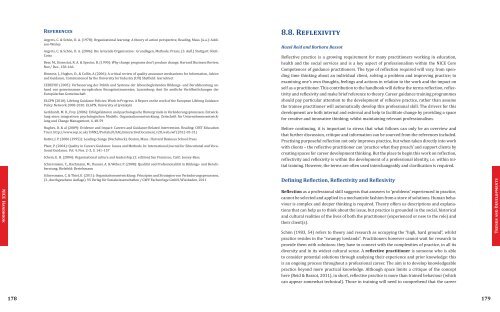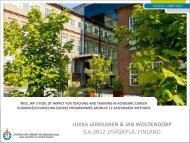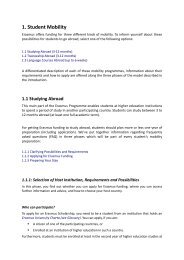Quality DevelopmentQuality in guidance is a multi-level problem, as was explained above. Accordingly, all types <strong>of</strong>quality-development activities have to clarify how they address the different levels which constantlyinteract with each other. In order to enable guidance practitioners to effectively participatein the evidence- and quality-based culture <strong>of</strong> tomorrow, the academic <strong>training</strong> in our fieldneeds to be aware <strong>of</strong> the interaction between these different levels in providing high-qualitycareer services. Practitioners need to be trained to effectively deal with the different levels. Onthe one hand, they need to be competent in working with their individual or organisationalclients. On the other hand, practitioners also need to be able to contribute to the development<strong>of</strong> an appropriate environment for effective services. In the <strong>NICE</strong> Core Competences (NCC),this aspect is taken into consideration in several ways. On the one hand, “Pr<strong>of</strong>essionalism”is considered a core competence <strong>of</strong> its own and refers to the ability <strong>of</strong> practitioners to continuouslyimprove their own competence, take ethical questions into account in their practiceand engage in the overall development <strong>of</strong> their field. Secondly, the NCC “Service & ProgrammeManagement” emphasises the need for guidance practitioners to be able to (co-) create theappropriate organisational environment for their practice. Finally, the NCC “Social SystemsInterventions” marks the need for guidance practitioners and service providers to effectivelywork together with other social systems (e.g. schools, employer <strong>network</strong>s, or civil services) inorder to reach their objectives.be applied as well in evaluation <strong>of</strong> quality activities as in practical application, and should betaught to guidance practitioners, so they can engaging in developing their own organisationsand effectively fill their role as change agents in their respective societal environments (NPR4 and 5).◆◆Need for content-related quality criteriaWhen quality is strongly associated with the effectiveness or impact <strong>of</strong> pr<strong>of</strong>essional services,as is more and more so for the field <strong>of</strong> career guidance, QMS need to be merged with standardsor guidelines in regards to desired effects, conditions etc. Not doing so would mean leaving itup to each guidance organisation to define what quality is on its own. The risk <strong>of</strong> not havingstandards for what quality is, lies in a total lack <strong>of</strong> transparency for users, and a low accountabilityfrom guidance providers, because literally everything can be defined as quality. Futureguidance pr<strong>of</strong>essionals need to be trained to understand the need <strong>of</strong> quality standards, andhow to work with quality criteria in their practice. They not only need to know how to assessand develop content-related quality criteria <strong>of</strong> guidance processes; they also need to understandthe different relevant streams <strong>of</strong> thought which underlie quality demands, for instanceto theories on career guidance or counselling processes, theories about pr<strong>of</strong>essionalization,organisational theory or governance theories in policy contexts (Schiersmann, Weber & al,2008).<strong>NICE</strong> HandbookOne particular issue which we would like to raise here is in regards to how quality managementand development systems are used and implemented in our field – <strong>of</strong>ten in concert withestablishing national or regional quality frameworks. Little attention has been paid to thisquestion in the career guidance & counselling discourse, although it is <strong>of</strong> vital importancefor securing and developing high quality guidance services. As we have pointed out above,guidance practitioners need to be trained in employing and introducing quality managementor development systems in their practice. Two aspects are <strong>of</strong> significant importance here fromour point <strong>of</strong> view:◆◆Need for procedural quality criteriaQuality management and development is typically associated with so-called quality managementsystems (QMS) such as ISO 9001:2008 or EFQM. These QMS generally establish formalprocedures in organizations in order to secure and develop the level <strong>of</strong> quality. Both introducinga QMS in an organisation, and employing it effectively, will lead to organisational changes.Depending on guidance practitioners’ competence to work with QMS, such organisationalchanges can be for the better or worse in regards to the quality <strong>of</strong> career services. Thus, futurepractitioners need to be trained to engage in developing their organisations and in employingQMS. Important insight about system change can be drawn from organisation developmentliterature (e.g. Argyris & Schön, 2006, 1978; Schein, 2004; Schiersmann & Thiel, 2011). Interms <strong>of</strong> effects and success in system change, theoretical work has been undertaken to describesuccess factors (Beer, 1990; Gerkhardt & Frey 2006; Kotter, 1995/2006). Such factors canResearch NeedsThere are several important questions which need to be addressed in regards to the quality <strong>of</strong>CGC services. One <strong>of</strong> the most central questions is in regards to the relation between differentsocietal levels and how they interact in providing high-quality, i.e. effective guidance services(Schiersmann/Weber et al 2008; Vuorinen & al 2011). Approaches which aim to discover theoutcomes and the impacts <strong>of</strong> guidance processes are a relevant part <strong>of</strong> this methodologicalrepertoire. The current developments have to be discussed, especially in terms <strong>of</strong> methodologicalimplications and in terms <strong>of</strong> the role such research and results can play in the improvement<strong>of</strong> guidance/counselling processes and services (Hughes 2009). In terms <strong>of</strong> a better(self-) organisation <strong>of</strong> high quality guidance services, we need specific answers which tools(e.g. evaluation, quality management, accreditation, <strong>training</strong>, or pr<strong>of</strong>essional supervision) ar<strong>eu</strong>seful to evoke and stabilize the needed change in specific situations. In essence this meansthat we need to optimize the magic triangle <strong>of</strong> research, higher education and innovation inpractice, by optimizing the connections between these fields: Higher education in guidancecan contribute to this process by:◆◆◆◆◆◆◆◆Offering continuing education to guidance pr<strong>of</strong>essionals;Engaging guidance students in field research;Training guidance students to develop their research competences;Supporting efforts to bring educators, students, researchers and practitioners togetherto discuss quality issues and develop innovative approaches for dealing with them.Trends and Developments176 177
ReferencesArgyris, C. & Schön, D. A. (1978): Organizational learning: A theory <strong>of</strong> action perspective, Reading, Mass. [u.a.]: Addison-WesleyArgyris, C. & Schön, D. A. (2006): Die lernende Organisation : Grundlagen, Methode, Praxis, (3. Aufl.) Stuttgart: Klett-CottaBeer, M., Eisenstat, R. A. & Spector, B. (1990): Why change programs don’t produce change. Harvard Business Review,Nov./ Dec., 158-166.Bimrose, J., Hughes, D., & Collin, A (2006): A critical review <strong>of</strong> quality assurance mechanisms for Information, Adviceand Guidance, Commissioned by the University for Industry (UfI) Sheffield: learndirectCEDEFOP (2005): Verbesserung der Politik und Systeme der lebensbegleitenden Bildungs- und Berufsberatung anhandvon gemeinsamen <strong>eu</strong>ropäischen Bezugsinstrumenten. Luxemburg: Amt für amtliche Veröffentlichungen derEuropäischen GemeinschaftELGPN (2010): Lifelong Guidance Policies: Work in Progress. A Report on the work <strong>of</strong> the European Lifelong GuidancePolicy Network 2008-2010. ELGPN, University <strong>of</strong> JyväskyläGerkhardt, M. D., Frey (2006): Erfolgsfaktoren und psychologische Hintergründe in Veränderungsprozessen. Entwicklungeines integrativen psychologischen Modells. Organisationsentwicklung. Zeitschrift für Unternehmensentwicklungund Change Management, 4, 48-598.8. ReflexivityHazel Reid and Barbara BassotReflective practice is a growing requirement for many practitioners working in education,health and the social services and is a key aspect <strong>of</strong> pr<strong>of</strong>essionalism within the <strong>NICE</strong> CoreCompetences <strong>of</strong> guidance practitioners. The type <strong>of</strong> reflection required will vary, from spendingtime thinking about an individual client, solving a problem and improving practice; toexamining one’s own thoughts, feelings and actions in relation to the work and the impact onself as a practitioner. This contribution to the handbook will define the terms reflection, reflectivityand reflexivity and make brief reference to theory. <strong>Career</strong> guidance <strong>training</strong> programmesshould pay particular attention to the development <strong>of</strong> reflexive practice, rather than assumethe trainee practitioner will automatically develop this pr<strong>of</strong>essional skill. The drivers for thisdevelopment are both internal and external and help to facilitate change by providing a spacefor creative and innovative thinking; whilst maintaining relevant pr<strong>of</strong>essionalism.Hughes, D. & al (2009): Evidence and Impact: <strong>Career</strong>s and Guidance-Related Intervention. Reading: CfBT EducationTrust. http://www.eep.ac.uk/ DNN2/Portals/0/IAG/interactiveDocument_v20_web.swf (2012-03-31)Kotter, J. P. (2006 (1995)): Leading change (Nachdruck). Boston, Mass.: Harvard Business School PressPlant, P. (2004): Quality in <strong>Career</strong>s Guidance: Issues and Methods. In: International Journal for Educational and VocationalGuidance. Vol. 4, Nos. 2–3, S. 141–157Schein, E. H. (2004): Organizational culture and leadership, (3. edition) San Francisco, Calif.: Jossey-Bass.Schiersmann, C., Bachmann, M., Dauner, A. & Weber, P. (2008): Qualität und Pr<strong>of</strong>essionalität in Bildungs- und Berufsberatung,Bielefeld: BertelsmannBefore continuing, it is important to stress that what follows can only be an overview andthat further discussion, critique and information can be sourced from the references included.Practising purposeful reflection not only improves practice, but when taken directly into workwith clients – the reflective practitioner can ‘practice what they preach’ and support clients bycreating spaces for career development thinking. But the place to begin this work on reflection,reflectivity and reflexivity is within the development <strong>of</strong> a pr<strong>of</strong>essional identity, i.e. within initial<strong>training</strong>. However, the terms are <strong>of</strong>ten used interchangeably and clarification is required.<strong>NICE</strong> HandbookSchiersmann, C. & Thiel, U. (2011): Organisationsentwicklung: Prinzipien und Strategien von Veränderungsprozessen,(3., durchgesehene Auflage). VS Verlag für Sozialwissenschaften / GWV Fachverlage GmbH, Wiesbaden, 2011Defining Reflection, Reflectivity and ReflexivityReflection as a pr<strong>of</strong>essional skill suggests that answers to ‘problems’ experienced in practice,cannot be selected and applied in a mechanistic fashion from a store <strong>of</strong> solutions. Human behaviouris complex and deeper thinking is required. Theory <strong>of</strong>fers us descriptions and explanationsthat can help us to think about the issue, but practice is grounded in the social, historicaland cultural realities <strong>of</strong> the lives <strong>of</strong> both the practitioner (experienced or new to the role) andtheir client(s).Schön (1983, 54) refers to theory and research as occupying the “high, hard ground”, whilstpractice resides in the “swampy lowlands”. Practitioners however cannot wait for research toprovide them with solutions: they have to connect with the complexities <strong>of</strong> practice, in all itsdiversity and in its widest cultural sense. A reflective practitioner is someone who is ableto consider potential solutions through analysing their experience and prior knowledge: thisis an ongoing process throughout a pr<strong>of</strong>essional career. The aim is to develop knowledgeablepractice beyond mere practical knowledge. Although space limits a critique <strong>of</strong> the concepthere (Reid & Bassot, 2011), in short, reflective practice is more than trained behaviour (whichcan appear somewhat technical). Those in <strong>training</strong> will need to comprehend that the careerTrends and Developments178 179






